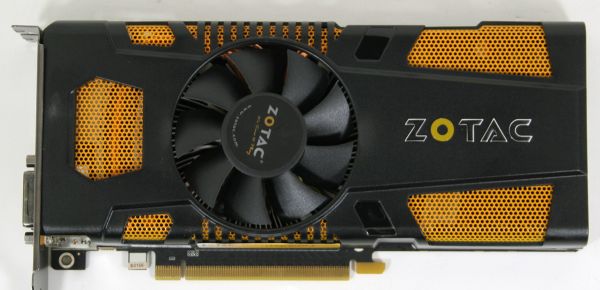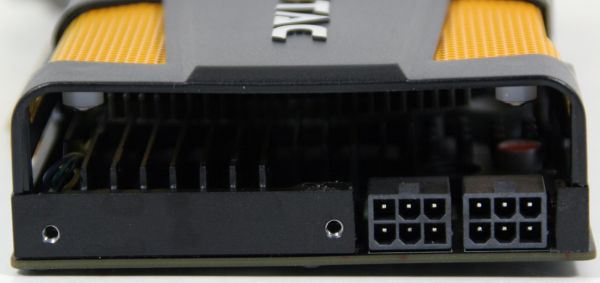NVIDIA's GeForce GTX 560 Ti w/448 Cores: GTX 570 On A Budget
by Ryan Smith on November 29, 2011 9:00 AM ESTMeet The Zotac GeForce GTX 560 Ti 448 Cores Limited Edition
There will be a number of GTX 560-448 cards launching today; most of NVIDIA’s partners will be involved, including Asus, EVGA, Gainward, Gigabyte, Inno3D, Palit, MSI and Zotac. Given that these will be custom designs no two cards will be alike, and while performance should be similar (accounting for clock differences), thermals and noise are going to vary with the design.
The card we’ve been sampled with is Zotac’s entry, the Zotac GeForce GTX 560 Ti 448 Cores Limited Edition. Zotac’s design is based on their existing GTX 570 design, which is an open-air cooler with copper heatpipes running up from the GPU to the heatsink. It’s effectively a bigger, more capable version of the GTX 560 Ti reference cooler, which means it shares the temperature and noise benefits of that design at a cost of dumping most of the heat produced inside your computer case.
While this isn’t an AMP product – AMP being Zotac’s factory overclock brand – Zotac is still goosing their GTX 560-448 by a bit. It will ship at 765MHz core instead of 732MHz (a 4% boost), while memory speeds are unchanged. It’s a bigger factory overclock than we’ve seen in some other cards, but 4% won’t make a huge difference in performance most of the time.
Breaking down the card it’s quite similar to other single-fan open-air coolers we’ve seen such as the reference GTX 560 Ti. Airflow is provided by a center fan with heatsinks covering the most important bits. The 2 6pin PCIe power sockets are placed at the rear of the card, which is not ideal but not a huge problem as the card is not particularly long.
For display connectivity Zotac is once again using their expanded offering. Along with the 2 DVI ports common on high-end NVIDIA cards, Zotac is also offering a full size HDMI port, and rare for an NVIDIA based card, a full size DisplayPort. Zotac achieves this by moving one of the DVI ports to the 2nd slot on the card’s bracket, which is a convenient location but further restricts the amount of air the card can eject outside of a computer case.
Along with the card, Zotac is continuing their tradition of bundling a game with their high-end cards. This time Zotac's North Amerian office is partnering with Electronic Arts, and they will be including a voucher for Battlefield 3 with their GTX 560-448 in North America. We’ve always been big fans of video cards including good games, so we’re glad to see Zotac continuing this tradition.
Rounding out the rest of the package is the typical collection of odds & ends: PCIe power adaptors, a multi-lingual quickstart guide, Zotac’s collection of OEM trialware, and a DVI to VGA dongle.
Between the overclock and the inclusion of Battlefield 3, it should come as no surprise that Zotac is charging above NVIDIA’s MSRP for the card. Zotac will be charging $299, $10 over MSRP – the overclock isn’t particularly impressive, but if you're in a territory that gets BF3, $10 for BF3 is a good deal any day of the week.













80 Comments
View All Comments
Transmitthis14 - Tuesday, November 29, 2011 - link
Many would ignore "Value" like that.I use Premier and Pshop, (cuda Acceleration) and also like the option of Physx with my Games when coded for.
So A 6950 then becomes a none option
Exodite - Wednesday, November 30, 2011 - link
Fringe benefits like those swing both ways though.I need three simultaneous display outputs, which render Nvidia options redundant in much the same way.
Looking strictly at price/performance, which is the metric most consumers would use in this case, the 2GB 6950 is indeed an excellent option.
grammaton.feather - Wednesday, November 30, 2011 - link
Oh really?http://www.overclock.net/t/909086/6950-shaders-unl...
I also agree with the CUDA argument. I have used Nvidia for years because of stereoscopic 3d support, more recently CUDA and PhysX and because I don't have driver crashes with Nvidia.
ATI may be better value for money at the cheap end of the spectrum, so long as u don't mind driver crashes.
A friend who used his high end PC for business had 170 plus ATI driver crashes logged by windows. I chose an Nvidia GPU for him and the crashing stopped.
rum - Wednesday, November 30, 2011 - link
I have had nothing but ATI cards since the 3870, and have NOT experienced these driver crashes you are speaking of.I use my computers for gaming and computer programming, and sometimes I do actually stress my system. :)
I am in the process of evaluating my video needs, as I do need a new video card for a new PC. I won't blindly go with ATI, I will EVALUATE all aspects and get the best card for the MONEY.
I don't need cutting edge, neither do most people, and we do evaluate things on most bang for the buck.
VoraciousGorak - Wednesday, November 30, 2011 - link
Funny, since I Fold on a GTX275, GTX460, and 9800GT on two different systems, and pretty often have NVIDIA's drivers lose their minds when finishing a WU, shutting down the system, or while simply processing a WU. I've tried multiple WHQL and beta drivers and settled with these being the least of my problems (the worst being total system unresponsiveness while Folding and a hard reset after a client stopped.) However, when I folded on my 6950 (granted, different client, but I Folded on it with the Beta client too) it never had a driver freakout, screen blank, or even a flicker when turning on or shutting off WUs.It seems to me that people that have major driver issues with AMD (not ATI anymore, by the way) cards are outliers, relative novices, and/or are using very outdated drivers or are recounting stories back from when the ATI 9700 series were new. I'm probably an outlier as well with my NVIDIA gripes, but characterizing a major modern GPU manufacturer with constant widespread driver issues or stating that any GPU is guaranteed to have problems is just silly.
silverblue - Thursday, December 1, 2011 - link
Oddly, those people who slate AMD are the ones who never ever seem to have an NVIDIA crash, or at least won't admit to one.Gorghor - Thursday, December 1, 2011 - link
I know this has no technical relevance, but I thought I'd share since my first reaction when I saw the article title, was "did I make a mistake buying an ATI6950?"For some reason I have been sticking to nVidia cards since the days of the Geforce 2. I made an exception with the ATI 9800 and although the performance was good back then, I had many problems with the drivers and really didn't approve of the catalyst control center.
When I upgraded my mainboard to the Sandy-bridge generation, I left my "old" GTX285 in the system and had several daily crashes related to the nVidia drivers (even after several months and driver updates).
About a month ago I decided it was time for me to upgrade the graphics. I wanted to stick to nVidia albeit the problems with my GTX285, but the price/performance ratio was just unacceptable when compared to AMD cards. I chose the ATI6950 2GB considering the same money would barely get me a GTX560.
I have to say I'm impressed. The performance is truly exceptional, even with no shader unlock, the catalyst interface has really matured over the years and my crashes are completely gone. So as far as I'm concerned, blindly going for nVidia is not an option anymore.
Golgatha - Tuesday, November 29, 2011 - link
what I take away from this review is the 560-448 is pretty much on par with a stock 570, but it will only be manufactured for roughly 2 months, and then be discontinued. Why would any gamer buy this card when they can get a superior card within $20 of this one and pretty much be guaranteed availability if they want to run SLI? Also, what's with the power connectors on the rear of the card. All of these long cards should situate those connectors on the top of the card.jigglywiggly - Tuesday, November 29, 2011 - link
I'd avoid it, you will probably be screwd with drivers in the long run.Samus - Tuesday, November 29, 2011 - link
As far as drivers and modern games go, people with ATI hardware have been having substantially more problems in Battlefield 3. Then the issue of microstutter arises which barely affects nVidia hardware, for what can only be presumed to be a ATI driver problem. Lastly, many people have experienced PowerPlay problems with Radeon 4000-5000 series cards running newer drivers due to clockspeed changes in-game, sometimes causing BSOD's, but always causing performance problems.nVidia has been, and always will be, the kind of drivers. The days of Mach64 still plague ATI's driver developement team. nVidia invented unified drivers and changed the game for the industry. They update their SLI profiles more than twice as often as ATI does for Crossfire, which alone shows their loyalty to their SLI users.
ATI has the hardware engineering team. That's clear. They can produce faster cards that use less power at lower prices. But you will NOT get superior drivers by a longshot.